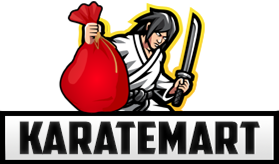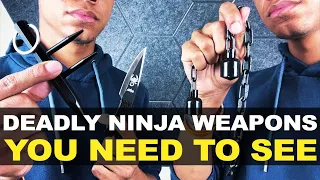The Real History of Nunchaku: From Farm Tool to Martial Arts Icon
October 30th, 2025
Long before the nunchaku became a symbol of lightning-fast martial arts moves and movie fight scenes, it was a simple farming tool used by Okinawan peasants. Born out of necessity during a time when weapons were banned, this unassuming pair of wooden sticks connected by a rope evolved into one of the most recognizable and respected weapons in the world. Its story weaves together ingenuity, cultural heritage, and the human instinct to adapt and survive. From rice fields to the big screen, the nunchaku's journey is a fascinating reflection of how tradition and creativity can transform something ordinary into something legendary.
The Mysterious Origins of the Nunchaku
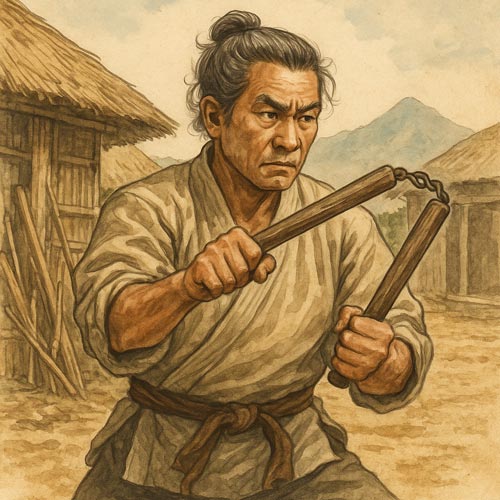
The exact origin of the nunchaku is difficult to trace, and its history is surrounded by a mix of legend and speculation. Most historians agree that it developed on the island of Okinawa, Japan, sometime between the 17th and 19th centuries, during a period when local citizens were forbidden from owning traditional weapons. As a result, farmers and villagers began adapting everyday tools for self-defense, leading to the birth of several improvised weapons that became staples of Okinawan martial arts.
One of the most popular theories suggests that the nunchaku was originally a rice or grain flail used to separate kernels from their husks. Its simple construction, with two sticks connected by a short rope, made it practical for threshing crops and easy to repurpose as a weapon when needed. Others believe it may have evolved from horse bridles or harness tools used for training animals, which had a similar design and motion. Regardless of its exact function, it is clear that the nunchaku's design came from the resourcefulness of rural people who found ways to defend themselves without violating the weapon bans of the time.
The weapon's simplicity and versatility ensured its survival through generations of Okinawan innovation. What began as a humble agricultural implement soon became a defining piece of Okinawan culture, laying the foundation for one of the most distinctive weapons in martial arts history.
Nunchaku in Okinawan Kobudo
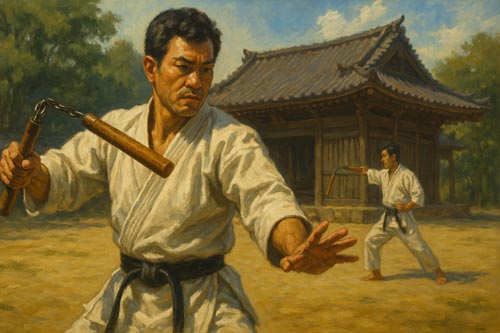
As the nunchaku evolved from its agricultural roots, it became an integral part of Okinawan kobudo, the traditional weapons system that developed alongside karate. Kobudo practitioners specialized in turning everyday tools into defensive weapons, and the nunchaku stood out for its speed, fluidity, and versatility. It could be used to strike, block, trap, or disarm an opponent, making it both practical and symbolic of Okinawan ingenuity.
Training with nunchaku in kobudo was not about aggression but about control and precision. Students learned to use the weapon as an extension of the body, mastering rhythm and timing through repetitive drills and kata. Early techniques emphasized defense, using the spinning motion to create barriers or deflect incoming strikes before transitioning into counterattacks. Because of its close-range effectiveness, the nunchaku became a valuable alternative to the staff and other long weapons that were more difficult to conceal.
Over the centuries, different Okinawan masters refined and passed down their own nunchaku methods. Figures such as Shinko Matayoshi helped formalize kobudo weapon training in the early 20th century, preserving the weapon's legacy and ensuring it remained a respected part of martial arts culture. Today, kobudo schools around the world still teach nunchaku techniques that can be traced back to these early Okinawan roots, keeping both the weapon's history and philosophy alive.
The Nunchaku's Journey Through Asia
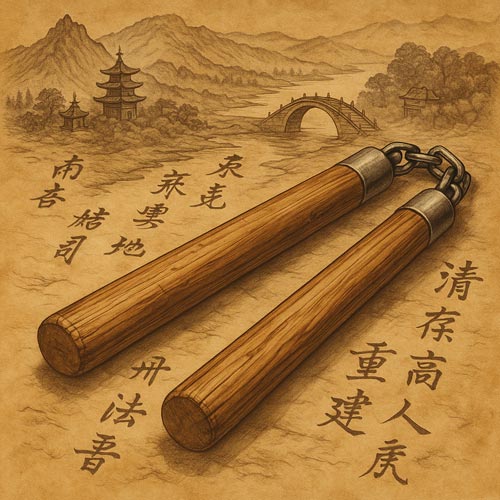
As martial arts spread throughout Asia, the nunchaku traveled with them, evolving slightly in design and technique depending on the region. From Okinawa, the weapon made its way to mainland Japan, where it was incorporated into various traditional training systems. Japanese practitioners often standardized the dimensions and introduced chain connections instead of simple ropes, giving the weapon greater durability and smoother motion during spins. This period also marked the beginning of formalized kata, or choreographed routines, which helped preserve and teach the weapon's techniques with precision.
In China, a similar weapon called the erjiegun had already existed for centuries, and some historians believe it may have influenced the Okinawan version. The erjiegun shared the same two-stick design but tended to be longer and more flexible, favoring whipping motions over direct strikes. As martial artists from different regions exchanged ideas, techniques began to blend, enriching the weapon's development and expanding its versatility.
Eventually, the nunchaku also reached Korea, where it became part of certain Hapkido and Taekwondo demonstrations. Korean practitioners focused heavily on rhythm, acrobatics, and fluidity, which helped popularize the weapon's performance aspect. Across Asia, the nunchaku transformed from a purely practical tool into a symbol of martial skill, discipline, and creativity. Each culture added its own flavor, shaping the nunchaku into the dynamic and adaptable weapon recognized today.
Bruce Lee and the Pop Culture Explosion
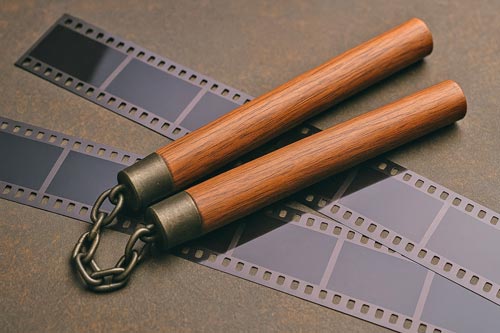
No figure in history has had a greater impact on the popularity of the nunchaku than Bruce Lee. When Enter the Dragon hit theaters in 1973, audiences around the world were captivated by his lightning-fast movements and effortless control of the weapon. For many, it was the first time they had ever seen nunchaku in action, and Lee's performances turned this once obscure martial arts weapon into a global phenomenon overnight.
Bruce Lee used the nunchaku not only for its visual appeal but also as a demonstration of fluidity, focus, and precision. His choreography emphasized continuous motion, where offense and defense flowed seamlessly from one to the next. The weapon became an extension of his body, perfectly embodying his philosophy of adaptability and freedom in combat. His films introduced the nunchaku to millions of viewers, inspiring countless martial artists, collectors, and fans to pick up their own pair and learn the art.
Ironically, Lee's influence also led to a wave of government restrictions. After his movies gained worldwide fame, several countries including parts of the United States, the United Kingdom, and Australia imposed bans on nunchaku due to public safety concerns. Despite these legal challenges, the weapon's mystique only grew stronger. By the late 1970s, toy and foam nunchaku flooded the market, becoming a staple of martial arts schools and pop culture. Bruce Lee had transformed a humble Okinawan tool into an enduring symbol of speed, skill, and cinematic power.
The Modern Role of Nunchaku
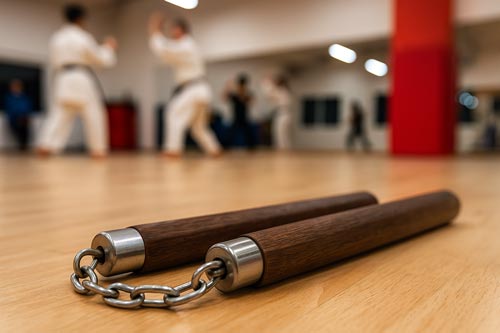
Today, the nunchaku continues to hold a respected place in martial arts, performance, and popular culture. While its use as a weapon has declined, it remains one of the most widely recognized symbols of martial training and discipline. Modern practitioners use it to improve hand-eye coordination, reaction time, and focus. Many martial arts schools include nunchaku training as a way to teach rhythm and control, emphasizing fluid movement rather than combat effectiveness.
In competitive martial arts, the nunchaku has evolved into a performance art of its own. Freestyle and exhibition competitors perform dazzling routines that combine traditional techniques with acrobatics, music, and choreography. Some modern versions feature LED lights or reflective finishes, making them visually striking under stage lighting. These performances honor the weapon's history while celebrating creativity and modern expression.
Beyond dojos and tournaments, the nunchaku has also found a place in movies, video games, and online culture. Its presence in entertainment continues to inspire new generations to learn about martial arts and its traditions. Despite changes in design and purpose, the nunchaku still represents precision, mastery, and adaptability. From ancient rice fields to cinematic battle scenes, its enduring legacy proves that this simple tool has become much more than a weapon; it is a lasting symbol of the spirit and artistry of martial culture.
Closing Thoughts
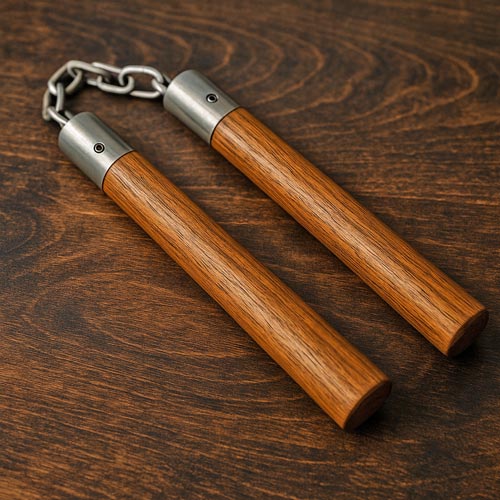
From its humble beginnings as a farming tool to its rise as a martial arts icon, the nunchaku's story reflects the enduring creativity and resilience of Okinawan culture. What began as an instrument of survival evolved into a symbol of artistry, discipline, and global influence. Every spin, strike, and flourish carries centuries of tradition that connect modern practitioners to those early innovators who found strength through necessity.
Today, the nunchaku stands not just as a weapon but as a bridge between past and present. It represents balance, control, and adaptability, qualities that extend far beyond martial training. Whether used in competition, performance, or personal practice, the nunchaku continues to inspire new generations to embrace focus, perseverance, and respect for history. Its legacy reminds us that even the simplest tools can achieve greatness when paired with human spirit and ingenuity. If you want to see traditional and modern examples of this iconic weapon, visit our full selection of nunchaku at KarateMart.com.
You May Also Be Interested In:
- The History of the Karambit: From Indonesian Farm Tool to Modern Tactical Icon
- Popular Martial Arts Weapons that Started as Farm Tools
- The Evolution of the Bowie Knife: From Frontier Tool to Collectible Icon
- The Most Dangerous Chain Weapons in Martial Arts History
- History of the Baton: From Police Nightstick to Self-Defense Tool
- From Jungle Tool to Movie Legend: The History of the Machete
- 10 Reasons Why You Should Try Martial Arts
- What is the Best Bo Staff for Martial Arts?
- What Gear Do I Need For My First Martial Arts Class?
- Should I Enroll my Child in the Martial Arts?
Leave a Reply

